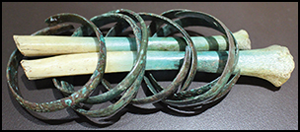Crossref Citations
This article has been cited by the following publications. This list is generated based on data provided by
Crossref.
Scherer, Andrew K.
2021.
Recent Research on the Archaeology of War and Violence.
Annual Review of Anthropology,
Vol. 50,
Issue. 1,
p.
403.
Hofstetter, Tobias
Vigouroux, Élodie
and
Elter, René
2022.
Enigmatic Bones: A Few Archaeological, Bioanthropological, and Historical Considerations Regarding an Atypical Deposit of Skeletonized Human Remains Unearthed in Khirbat al-Dusaq (Southern Jordan).
Open Archaeology,
Vol. 8,
Issue. 1,
p.
1010.
González-Rabanal, Borja
Marín-Arroyo, Ana B.
Cristiani, Emanuela
Zupancich, Andrea
and
González-Morales, Manuel R.
2022.
The arrival of millets to the Atlantic coast of northern Iberia.
Scientific Reports,
Vol. 12,
Issue. 1,
González-Rabanal, Borja
Marín-Arroyo, Ana B.
Vidal-Cordasco, Marco
Martín, Miguel Ángel
and
Ortega, Ana Isabel
2023.
Early Bronze Age violence in Ojo Guareña (Merindad de Sotoscueva, Burgos, Spain). Perimortem modifications in two male individuals.
Quaternary Science Advances,
Vol. 12,
Issue. ,
p.
100120.
Fernández-Crespo, Teresa
Ordoño, Javier
Etxeberria, Francisco
Herrasti, Lourdes
Armendariz, Ángel
Vegas, José I.
and
Schulting, Rick J.
2023.
Large-scale violence in Late Neolithic Western Europe based on expanded skeletal evidence from San Juan ante Portam Latinam.
Scientific Reports,
Vol. 13,
Issue. 1,
Moreno‐Ibáñez, Miguel Ángel
Saladié, Palmira
Ramírez‐Pedraza, Iván
Díez‐Canseco, Celia
Fernández‐Marchena, Juan Luis
Soriano, Eni
Carbonell, Eudald
and
Tornero, Carlos
2024.
Death in the high mountains: Evidence of interpersonal violence during Late Chalcolithic and Early Bronze Age at Roc de les Orenetes (Eastern Pyrenees, Spain).
American Journal of Biological Anthropology,
Vol. 184,
Issue. 1,
Fernández-Götz, Manuel
and
Roymans, Nico
2024.
Archaeology of the Roman Conquest.
de la Fuente-Seoane, Rubén
López-Onaindia, Diego
Codina Falgas, Ferran
De Prado, Gabriel
Álvarez, Conxita Ferrer
Rovira Hortalà, M. Carme
Díaz-Zorita Bonilla, Marta
Nieto-Espinet, Ariadna
and
Subirà, M. Eulàlia
2025.
Territorialisation and human mobility during the Iron Age in NE Iberia: An approach through Isotope Analyses of the Severed Heads from Puig Castellar (Barcelona, Spain) and Ullastret (Girona, Spain).
Journal of Archaeological Science: Reports,
Vol. 62,
Issue. ,
p.
105035.



